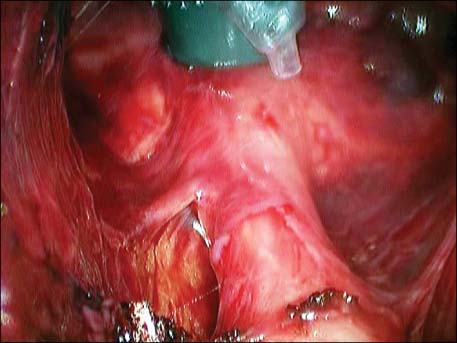J Korean Surg Soc.
2010 Apr;78(4):267-269. 10.4174/jkss.2010.78.4.267.
Laparoscopic Extraperitoneal Resection of Urachal Cyst
- Affiliations
-
- 1Department of Surgery, Korea University College of Medicine, Seoul, Korea. hymoon@korea.ac.kr
- 2Hansarang GS Clinic, Seoul, Korea.
- KMID: 1750742
- DOI: http://doi.org/10.4174/jkss.2010.78.4.267
Abstract
- Remnant urachal cyst is a rare anomaly with an incidence of 1:5,000 and the majority are benign. The treatment of urachal cyst is complete surgical resection, and the cases of laparoscopic surgery for the resection have been reported since 1993. Most of the reports were about transabdominal laparoscopic approach, and it has been revealed that multiple skin incisions and trocar placements on upper abdomen were ineludible. With this condition, we are able to describe an extraperitoneal approach modified from total extraperitoneal herniorrhaphy, and to report a case of successful management of a urachal cyst by total extraperitoneal laparoscopic excision.
Keyword
Figure
Reference
-
1. Begg RC. The urachus: its anatomy, histology and development. J Anat. 1930. 64:170–183.2. Berman SM, Tolia BM, Laor E, Reid RE, Schweizerhof SP, Freed SZ. Urachal remnants in adults. Urology. 1988. 31:17–21.3. Guarnaccia SP, Mullins TL, Sant GR. Infected urachal cysts. Urology. 1990. 36:61–65.4. Siegel JF, Winfield HN, Valderrama E, Smith AD. Laparoscopic excision of urachal cyst. J Urol. 1994. 151:1631–1633.5. Fahlenkamp D, Schonberger B, Lindeke A, Loening SA. Laparoscopic excision of the sinusoidal remnants of the urachus in a 3-year-old boy. Br J Urol. 1995. 76:135–137.6. Durstein-Decker C, Brick WG, Gadacz TR, Crist DW, Ivey RK, Windom KW. Comparison of adhesion formation in transperitoneal laparoscopic herniorrhaphy techniques. Am Surg. 1994. 60:157–159.7. Bowne WB, Morgenthal CB, Castro AE, Shah P, Ferzli GS. The role of endoscopic extraperitoneal herniorrhaphy: where do we stand in 2005? Surg Endosc. 2007. 21:707–712.8. Cadeddu JA, Boyle KE, Fabrizio MD, Schulam PG, Kavoussi LR. Laparoscopic management of urachal cysts in adulthood. J Urol. 2000. 164:1526–1528.9. Choi YJ, Kim JM, Ahn SY, Oh JT, Han SW, Lee JS. Urachal anomalies in children: a single center experience. Yonsei Med J. 2006. 47:782–786.10. McCormack K, Wake BL, Fraser C, Vale L, Perez J, Grant A. Transabdominal pre-peritoneal (TAPP) versus totally extraperitoneal (TEP) laparoscopic techniques for inguinal hernia repair: a systematic review. Hernia. 2005. 9:109–114.




